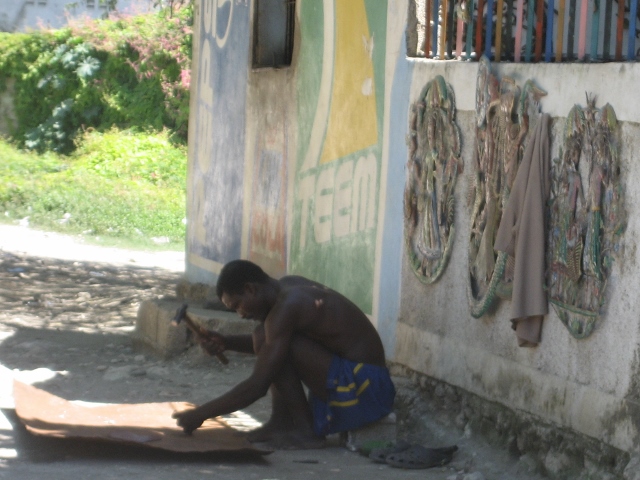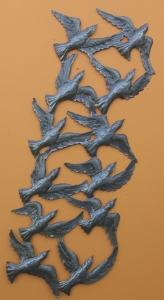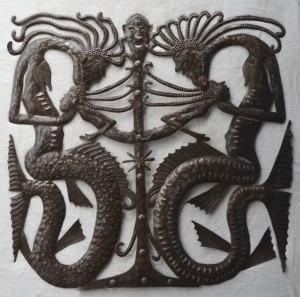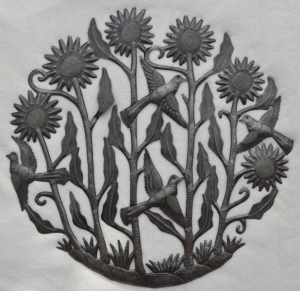November 12, 2013

These old discarded steel drums are soon to become beautiful folk art sculptures. Recycling at its finest!
I’m going to cheat a little bit and not write a blog this week. I just found out that this Friday, November 15th is America Recycles Day. (Yes, I live in a cave. A dark one. Very little outside exposure.) Because protecting the environment is very near and dear to the hearts of all of us at Beyond Borders, I’m going to pass along these reminders, published by Keep America Beautiful, Inc. of how we can all do a better job of taking care of each other and our planet by recycling.
Did you know…
1. Half is better than none. You may not be able to recycle your whole pizza box, but in most communities you can tear off the top (as long as it’s grease-free) and put it in your recycling bin.
2. You bet your bottle tops you can recycle them. The caps on your plastic bottles are recyclable, too. Empty your bottle, replace the cap, and recycle.
3. Plastic bag and film recycling: more than grocery bags. Along with plastic grocery bags, recycle the bags from your dry-cleaning, loaf of bread, and newspaper. Remember to take clean, dry bags to recycling centers or retailers with plastic bag recycling bins.
4. A trick up your sleeve. Paper cups aren’t always recyclable because of the wax lining, but don’t forget to recycle the cardboard sleeve!
5. Look beyond the daily paper. According to the U.S. Environmental Protection Agency (EPA), paper and cardboard are America’s most recycled materials by weight. In addition to newspaper, most communities accept corrugated cardboard as well as cereal and tissue boxes. Some accept mail, catalogs and phone books.
Make Recycling a Habit
6. Close the loop. The recycling process doesn’t stop at the bin! After materials are processed and back on the shelf as new items, it’s up to you to buy recycled products. Look for products and packaging with recycled content (and efficient packaging) to do your part as a recycling-conscious consumer.
7. Recycle on the go. Keep two bags in your car – one for your trash and one for recyclables. Pre-sorting makes it easier to transfer your recyclables into a recycling bin once you’ve reached your destination.
8. Recycling: it’s not just in the kitchen. Don’t trash your detergent and shampoo bottles just because you don’t have a bin in your bathroom or laundry room. Keep a plastic bag for collecting recyclables under the sink or take a few extra steps to put your empty bottles in the recycling bin.
9. Reduce and reuse. Minimizing the trash we generate and reusing products reduces our impact on the planet and our resources. For example, consider reusing that plastic bag. Also reduce unwanted direct mail by unsubscribing at CatalogChoice.org.
10. Know your limits. Putting materials in your recycling bin that aren’t collected in your community contaminates the recycling process and creates extra work for recycling facility employees. To recycle items that your local program does not collect, check AmericaRecyclesDay.org to find where they may be recycled in your community.
Actions You Can Take Now
11. Can it! Metals are among the most valuable materials in the recycling stream. Aluminum and steel cans are always welcomed by recyclers, and most metals can be recycled again … and again … and again.
12. Answer the call to recycle your wireless phone! More than 100 million cell phones retire each year to sit in our drawers or closets, according to the EPA. Do you have out-of-use phones in your home? Consider donating them to a local charity or visit AmericaRecyclesDay.org to find a recycler.
13. Recycling: don’t exclude your food. Start composting your food waste. If you aren’t quite ready for a compost bin or pile, consider tossing a few biodegradable items into your garden or window boxes instead of the trash. Egg shells and coffee grounds enrich soil and break down easily.
14. Do your homework. Different communities collect different materials for recycling. Visit AmericaRecyclesDay.org to find what is recycled in your community.
15. Spread the word. Now that you’re an expert recycler, consider hosting an educational recycling event in your community. See AmericaRecyclesDay.org/toolkit for ideas and resources that can be downloaded.
About Keep America Beautiful, Inc.
Keep America Beautiful is the nation’s leading nonprofit that brings people together to build and sustain vibrant communities. With a network of more than 1,200 affiliate and participating organizations including state recycling organizations, the organization works with millions of volunteers to take action in their communities. KAB offers solutions that create clean, beautiful public places, reduce waste and increase recycling, generate positive impact on local economies and inspire generations of environmental stewards. Through programs and public-private partnerships, KAB engages individuals to take greater responsibility for improving their community’s environment. For more information, visit www.kab.org. To join America Recycles Day, visit http://americarecyclesday.org.

Outside a workshop in Croix-des-Bouquets, recycling is in progress.










![3150[1]](https://blog.itscactus.com/wp-content/uploads/2014/02/31501.jpg)
![ad7395ccb8072aca766cd4ff4c9c7d81[1]](https://blog.itscactus.com/wp-content/uploads/2014/02/ad7395ccb8072aca766cd4ff4c9c7d811.jpg)


![images[10]](https://blog.itscactus.com/wp-content/uploads/2014/01/images10.jpg)







